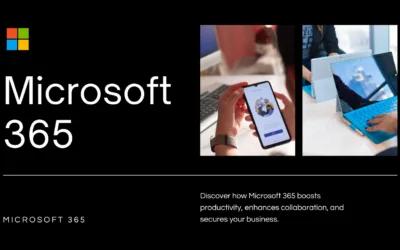Effective endpoint device management is essential for businesses aiming to safeguard their assets, optimise productivity, and maintain operational efficiency. Microsoft 365 offers a powerful suite of tools, including Intune, Azure Active Directory (Azure AD), and Microsoft Endpoint Manager, to streamline this critical aspect of IT management. These tools work together to provide comprehensive solutions for overseeing and securing endpoint devices across an organisation. In this article, we will explore how Microsoft 365’s endpoint management capabilities can significantly benefit your business, enhancing both security and efficiency.
What is Endpoint Device Management?
Endpoint device management refers to the administration and control of devices such as computers, smartphones, tablets, and other endpoints within an organisation. Proper management involves ensuring these devices are secure, updated, and compliant with organisational policies.
Key Components of Microsoft 365 for Endpoint Device Management
1. Microsoft Intune:
– Device Configuration and Management: Intune allows IT administrators to configure and manage settings on a variety of devices. This includes deploying policies, applications, and updates across devices.
– Application Management: With Intune, businesses can control which apps are installed and manage app configurations and updates. This helps ensure that employees have the tools they need without compromising security.
– Conditional Access: Intune provides advanced security features, such as conditional access policies, which ensure that only compliant devices can access company resources.
2. Azure Active Directory (Azure AD):
– Identity and Access Management: Azure AD integrates with Intune to provide robust identity and access management. It supports single sign-on (SSO) and multi-factor authentication (MFA), enhancing security and user convenience.
– Device Compliance and Conditional Access: Azure AD works with Intune to enforce compliance policies and conditional access rules, ensuring that only devices meeting specific criteria can access corporate resources.
3. Microsoft Endpoint Manager:
– Unified Management: Microsoft Endpoint Manager combines Intune and Configuration Manager, offering a unified platform for managing endpoints. This consolidation simplifies administrative tasks and provides a single pane of glass for IT administrators.
Benefits of Using Microsoft 365 for Endpoint Device Management
1. Enhanced Security:
– Unified Security Policies: Centralised management through Intune and Azure AD ensures consistent security policies across all devices. This reduces the risk of vulnerabilities and data breaches.
– Advanced Threat Protection: Microsoft 365 integrates with advanced security solutions such as Microsoft Defender, providing proactive threat protection and real-time alerts.
2. Increased Productivity:
– Seamless User Experience: Features like SSO and streamlined application deployment enhance user productivity by minimising login hassles and ensuring that employees have the tools they need when they need them.
– Automated Updates and Configurations: Automated deployment of updates and configurations reduces the time IT staff spend on manual tasks, allowing them to focus on more strategic initiatives.
3. Simplified Management:
– Centralised Control: Microsoft Endpoint Manager provides a single interface for managing all devices, reducing the complexity associated with handling different device types and operating systems.
– Scalability: Whether your organisation is expanding or scaling down, Microsoft 365’s cloud-based solutions easily adapt to changing needs without requiring significant infrastructure changes.
4. Cost Efficiency:
– Reduced IT Overhead: Automating routine tasks and leveraging cloud-based management tools can lower operational costs and reduce the need for extensive on-premises hardware.
– Predictable Licensing Costs: Microsoft 365 offers flexible licensing options that can align with your organisation’s size and requirements, helping manage IT budgets more effectively.
5. Compliance and Governance:
– Policy Enforcement: Intune and Azure AD support compliance with various regulatory requirements by enforcing security and data protection policies.
– Audit and Reporting: Built-in reporting and auditing features provide visibility into device compliance and security status, helping organisations meet internal and external governance standards.
Conclusion
Microsoft 365’s suite of tools, including Intune, Azure AD, and Microsoft Endpoint Manager, provides a robust framework for managing endpoint devices efficiently and securely. By leveraging these tools, businesses can enhance security, boost productivity, streamline management processes, and achieve cost efficiencies. As the digital workspace continues to evolve, adopting a comprehensive endpoint device management strategy with Microsoft 365 can position your organisation for long-term success and resilience.
By implementing Microsoft 365 for endpoint device management, your business can enjoy enhanced security, increased productivity, simplified management, and cost efficiency, all while ensuring compliance and governance.




0 Comments